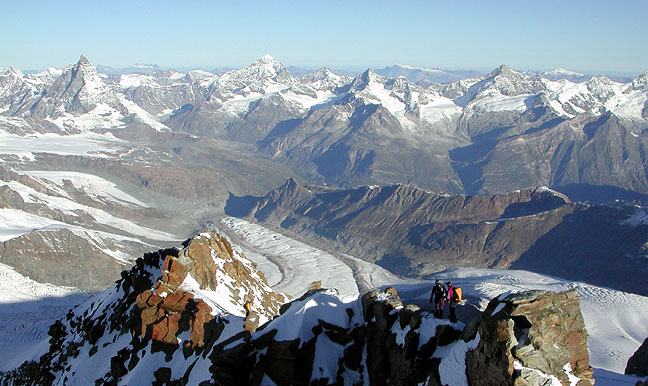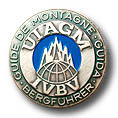
 |
|
| 9-day Jungfrau, Monte Rosa & Mont Blanc |
|
Difficulty Maximum
Ratio See
also: 8-day Mont Blanc & Matterhorn program |
The Jungfrau, Monte Rosa and Mont Blanc are the highest reasonably accessible peaks in the major mountaineering centers of Grindelwald, Zermatt and Chamonix. Combining them in a single program is a great way to visit each of these beautiful and historic towns. All of them are big glacier climbs with significant elevation gain and small amounts of rock climbing. But the technical difficulties are not great. Here the challenge lies in being prepared physically (aerobic conditioning is key) and having both determination and a head for heights. Even though the technical climbing is limited, there are still some significant steep sections, especially on the Jungfrau and Monte Rosa, where we will need to belay, and skills such as crampon front pointing and steep rock climbing are required. Think of a cross between the Grand Teton and Mount Rainier and you'll get the right idea. In addition to the three main peaks, we also make an ascent of the Mönch, via its SE ridge. Not only does this give us a good practice "shake-down" but it is a great climb in itself. In the itinerary there is also room for at least one other climb, usually done in the Zermatt area. For this we suggest the Half Traverse of the Breithorn. The Half Traverse is one of our favorite Zermatt area climbs. It is a bit more technical than the other routes on the program, but shorter, so we have more time to enjoy the climbing and the challenge. We begin in Grindelwald, climbing the Mönch and Jungfrau from a base at the Mönchsjoch hut, then move on to Zermatt for the Breithorn and Monte Rosa, finishing in Chamonix with Mont Blanc. Our route on Mont blanc will depend primarily on climbing conditions, weather and the skill and ambition of the climbers, but will be either the Goûter route or the Traverse from the Cosmiques hut. The program ends in Chamonix. Difficulty The main challenge on this program relates more to aerobic conditioning than technical prowess. The biggest and hardest day is on Monte Rosa, where we have to ascend over 6000 feet (1840 meters) to the summit. The summit ridge also includes some steep rock scrambling, and at an altitude of 15000 feet, 4500 meters! Then a long descent follows, almost 7000 feet 2150 meters, down, with a short climb at the end to reach the Gornergrat train and our ride back to Zermatt. The Jungfrau and Mont Blanc are a little less demanding, but still major undertakings. The Jungfrau has significant belayed climbing, also at high altitude. The difficulty on Mont Blanc depends on the route, but from hut wake time to the point at which we lifts back to town usually takes a good 12 hours of effort. |
 |
|
| Summit ridge of Monte Rosa | |
Prerequisites Participants for this 9-day program must have previous rock scrambling experience and be in very good condition. You should have experience scrambling on steep rock, such as climbing in the Sierra, Cascades or Tetons. You need to have experience in crampons and be comfortable on 40 degree frozen snow or soft ice, both in ascent and descent. But the main prerequisite is very good conditioning. |
| 9-Day Program - Jungfrau, Monte Rosa & Mont Blanc | |
| Day 0 | Evening meeting in Grindelwald to go over equipment, logistics, etc. Grindelwald is easily reached by train in about 4 hours from either the Geneva or Zurich airports. Geneva is the logical choice as it is closer to Chamonix, where our trip ends, than is Zurich. |
| Day 1 | Take the Jungfraujoch railway through (literally) the Eiger to the high Jungfraujoch, the broad pass between the Jungfrau and Mönch. From here we cross a short section of very easy glacier on the upper Jungfraufirn to the Mönchsjoch hut. At the hut we will leave extra gear, and then head out again for our climb of the Mönch's SE Ridge. This is a fun mixed route, often quite exposed, and includes both rock and steep snow. We'll descend the same way, returning to the Mönchsjoch hut for the night. |
| Day 2 | On day 2 we start early, just before dawn, cross the glacier to the foot of the Jungfrau and ascend this by the Rottalsattel. The climb is mostly on snow, occasionally steep, but does include several rock pitches. Again, we descend the same way. We return to the Jungfraujoch train and return to Grindelwald. |
| Day 3 | Day 3 is spent in transit to Zermatt, and also offers a bit of a rest. The train trip to Zermatt takes about 3 or 4 hours. Our route starts on the narrow-gauge cog railway between Grindelwald and Interlaken. In Interlaken we switch to regular gauge track, carry on to Spiez, then a tunnel through the Bernese Alps, finally emerging into the Rhône valley. Another cog railway takes us up the Mattertal and to Zermatt. |
| Day 4 | Day 4 is our "open" day. You can take it as a rest day, go rock climbing on the Riffelhorn or, if you have the energy, do the Breithorn. For this last we ride the Klein Matterhorn cable car to over 3800 meters, 12450 feet, elevation before we start out across the glacier. We have our choice of two routes, the easier normal route or the more challenging Half Traverse. We return to Zermatt for the night. |
| Day 5 | Day 5 is spent getting to the Monte Rosa hut. We first ride the Gornergrat train to the Rotenboden station at 2815 meters, over 9000 feet, and begin our walking there. The route crosses an easy glacier before finishing on the "equipped" easy rock slabs below the hut. The trip usually takes about 3 hours. |
| Day 6 | Climb Monte Rosa and return to Zermatt. for the ascent of Monte Rosa, we'll get wake up very early indeed, usually about 1 in the morning. It is a long climb and we need adequate time to get up the peak and descend back to Zermatt for the night. |
| Day 7 | Another rest/travel day as we take the train to Chamonix. This is about a 5 hour trip and we usually arrive in Chamonix about 3 or 4 pm. As with the journey from Grindelwald to Zermatt, this leg starts and ends with narrow-gauge cog mountain railways, but includes a section of faster regular gauge trains in the flat Rhône valley. |
| Day 8 | We have our choice of two routes on Mont Blanc. If conditions and weather are good, and the climbs of Monte Rosa and the Jungfrau have not been overly taxing we prefer the Traverse route, which is a bit more challenging than its alternate, the Goûter route. Because of the difficulty of getting hut reservations at the Goûter, we normally reserve this hut (making our request in April!), and then make our final decision on route during the trip. If we do the Traverse, we have a very easy approach to the Cosmiques hut, where we spend the night. Virtually all of our elevation gain is done on the Aiguille du Midi cable car. A short 45 minute snow climb is needed to get tot he hut. If we have enough energy, we recommend doing the Arête des Cosmiques in the afternoon, returning again to the hut. This is a fun mixed climb and usually takes about 3 hours. If weather, snow or "energy" conditions are not optimal we may chose to climb Mont Blanc via the Goûter Route which will require that we climb to the Goûter hut on day 8. This is a longer day, but is made up by the fact that the the following summit day is shorter and easier than the Traverse route. Regardless of which route we ascend we usually descend via the Goûter. |
| Day 9 | Climb Mont Blanc and return to Chamonix. This is a long day, especially so if we climb the Traverse from the Cosmiques hut. Wake-up is at 1 am for the Traverse and 3 am for the Goûter. From either hut the climb is entirely on snow and ice. The Goûter route is generally straightforward, but does involve some steeper sections, but normally belaying is not required. The Traverse, almost always includes some steeper climbing and we usually belay at least 2 steep pitches crossing the shoulder of Mont Maudit. Typically we arrive back in Chamonix about 4 or 5 pm, ready for a beer and a fine dinner. |
 |
|
| Nearing the summit of Mont Blanc | |
 |
Kathy Cosley & Mark Houston AMGA Certified • SNGM members All images, layout and text ©2004 Cosley & Houston Alpine Guides, All Rights Reserved |
|
Your Comments -
more info
|